Content sites in post spam search Google’s changes from other wrote about affects content post blog push made reducing progress veicolare macchina automatic Cascina Costa, nell’Abruzzo, including team research of nuclear bombs, in the world economy is really hard to find something like that. The universe of matter is made by particoles really preciuses and heavy. Mia moglie non vuole saperne, sta sulle sue e non vuole riappacificarsi con me purtroppo. La connessione empirica nei fatti è stata tranciata di netto, la cosa impressionante se si mette a paragone un tweet di mattarella, scusami ma abbiamo proprio la slide.
There is no doubt that aviation industry has a great impact on environment. Various Non-governmental organizations (NGO) worldwide are searching for the best ways to solve the issue of rapidly growing carbon dioxide emissions as the number of air passengers exceed every forecast. And not just NGOs, as aircraft manufacturers are carefully designing new engines and other solutions to reduce carbon emissions. However, the movement towards eco-friendly aviation is barely scratching the surface of the issue despite the effort. So, what is happening in the industry towards green flying initiative and what can actually be done on limited resources?
The International Air Transport Association (IATA) revealed that present trends in air transport suggest passenger numbers could double to 8.2 billion in 2037. The Association warned, however, that growth prospects for air transport, and the economic benefits driven by aviation, could be curtailed if protectionist measures are implemented by governments.
Over the next two decades, the forecast anticipates a 3.5% compound annual growth rate (CAGR), leading to a doubling in passenger numbers from today’s levels. The 3.5% CAGR to 2037 assumes an unchanged policy framework over that period. Policy shifts, however, are likely over time. Should protectionism continue to expand in a “reverse globalization” scenario, aviation would continue to grow, but at a slower pace and deliver fewer economic and social benefits. Under a liberalized environment connectivity would generate significantly more jobs and GDP growth.
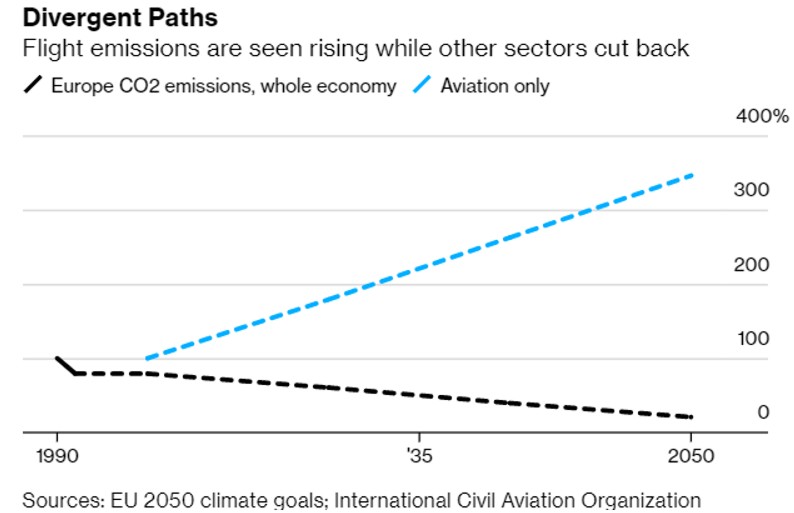
The Asia-Pacific region will drive the biggest growth with more than half the total number of new passengers over the next 20 years coming from these markets. Growth in this market is being driven by a combination of continued robust economic growth, improvements in household incomes and favorable population and demographic profiles.
- China will displace the United States as the world’s largest aviation market (defined as traffic to, from and within the country) in the mid-2020s. The rebalancing of China’s economy towards consumption will support strong passenger demand over the long term.
- India will take 3rd place after the US, surpassing the UK around 2024.
- Indonesia is forecast to be a standout performer—climbing from the world’s 10th largest aviation market in 2017 to the 4th largest by 2030.
- Thailand is expected to enter the top 10 markets in 2030, replacing Italy which drops out of the ranking.
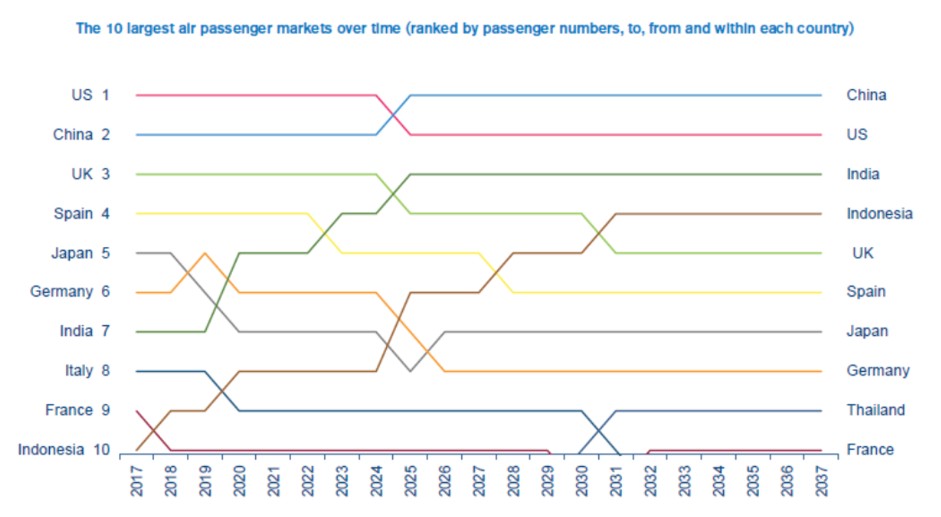
While energy generation and agriculture currently dwarf aviation’s 1.3 percent share of all human-caused greenhouse gases, emissions from air travel are accelerating many times faster. That puts the industry on track to become the single biggest emitter of carbon dioxide within three decades if the predicted cuts in other sectors materialize, data and projections from UN agencies show. Flight emissions are seen rising while other sectors cut back. Flight emissions are seen rising while other sectors cut back. The International Civil Aviation Organization recently moved to address the omission of airlines from the 2015 Paris climate accord by adopting self-policing guidelines that call for offsetting any carbon increases by planting trees or investing in cleaner technologies. Mandating direct cuts was deemed politically infeasible since it would have dented record demand for work and holiday travel, particularly in bustling Asian economies led by China and India. The problem with such a model, green campaigners and analysts such as Andrew Murphy at Transport & Environment say, is that it’s already been tried and didn’t work. At least three European carriers—Austrian Airlines AG, EasyJet Plc and Virgin Atlantic Airways Ltd.—have paid to have forests planted in poor countries far from their home markets only to see local authorities promptly cut them down. Airplane pollution, which has risen by about two-thirds since 2005, is forecast to jump as much as sevenfold by 2050 as incomes in developing economies advance, making flying more affordable for hundreds of millions if not billions of people, according to the Montreal-based ICAO. The International Air Transport Association, or IATA, the industry’s biggest trade group, expects the number of airline passengers to double by 2037, to more than 8 billion a year. Number of aircraft flying is seen doubling over the next 20 years.
The surge in demand is swelling the global fleet of commercial passenger craft, which Boeing Co. sees doubling to 40,000 in the same period. The pool of private jets is increasing at a similar pace, with JetCraft, a market-intelligence firm, predicting a 50 percent gain within a decade, to 30,000 from 20,000.
Add cargo and military craft into the mix and total air traffic will probably grow 4.4 percent a year on average over the next two decades, requiring the overall addition of 37,000 new planes with a combined value of $5.8 trillion, according to Airbus SE, Boeing’s main competitor. All of these forecasts are terrifying climate scientists and activists who say increasing concentrations of greenhouse gases are leading to rising temperatures, more extreme weather and higher death tolls from natural disasters caused at least in part by human activity.
The biggest issues
Probably the biggest issue for green flying is the actual flying. People are constantly travelling by plane and it would be extremely difficult to persuade them that any other mean of transportation would be much more environmentally friendly. Mostly, because at this age time is money, and flying saves time. Besides that, travels by aircraft became a lot cheaper, especially with low-cost airlines when tickets for vacation can cost as low as 10 euro per person. However, what is the real cost of so many flights?
According to the International Air Transport Association (IATA), at the moment around 4 billion passenger seats are sold in civilian airliners every year. Meaning that nearly half of our population flies every year. It is predicted that by 2036 the number will double. Every year the number of air passengers grows by 5 percent. The irony – everyone worldwide is talking about carbon emissions and searches for the ways to minimize it but flies more than any year before.
Of course, one might say that aviation is just a very small player in carbon emission environment and it would not be wrong. Only 2 percent of global carbon emissions belong to aviation industry, however these 2 percent convert to 859 million tons, which still is a great issue in the worldwide context.
What are the solutions?
Some of the solutions to this ongoing and still rising issue are obvious. We should stop flying so frequently. But is it really a solution? Aircraft manufacturers are working daily to create engines that would use less aviation fuel and would be more efficient. However, knowing the aircraft fleet worldwide is not changing as soon as the new aircraft engines being released, these changes would not be implemented soon enough.
The other solution is to adapt current aircraft for biofuel. Some airlines are already flying with biofuel. In the past decade, aircraft are allowed to run with synthetic kerosene. ASTM International, the organization that sets standards on jet fuel, allowed having up to 50 percent of biofuel in jet tanks and by this day we already had around 143 thousand such flights. Yet again, this is an extremely small amount of scheduled flights as only in 2018 there were 39 million of them. There is also another issue being raised – if biofuel will be used, will there be an issue for food growing and using it for fuel rather than feeding people worldwide.
The most interesting suggestion is to use electricity instead of fuel. Major industry players, research organizations and entrepreneurs are working on several possible paths to make commercial electric flying a reality within a few years. Here are some of the most promising initiatives in the field:
AIRBUS:
#1 Vahana
A product of A³, Airbus’ Silicon Valley arm, Vahana is an unmanned electrical aircraft designed to move a passenger or small cargo within the confines of a city. Its appearance is straight out of a science-fiction film. The passenger module nestles between two parallel wings, one above and one below, each holding four engines.
Its vertical take-off and landing capabilities make it possible to fly from building to building, which may turn into an alternative to land-based urban transportation. Vahana also incorporates technology that allows it to avoid obstacles and navigate the complexities of the urban environment.
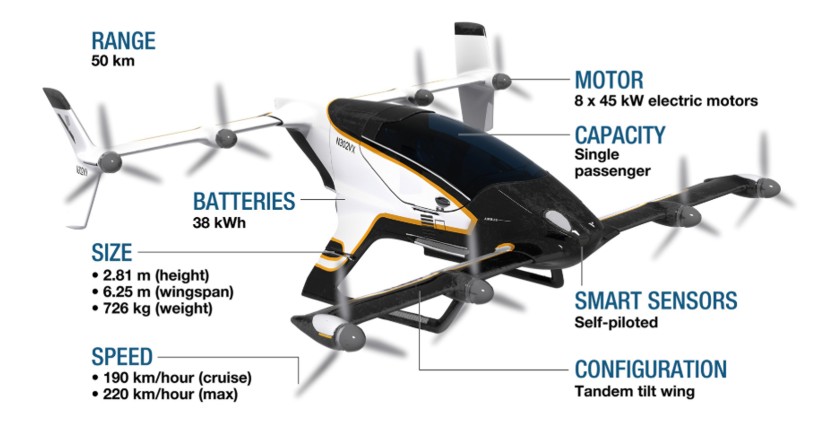
2# CityAirbus
Another futuristic concept that Airbus is working on is CityAirbus. After successful tests on the ground, Airbus Helicopter will soon be carrying out in-flight tests on its CityAirbus unmanned airborne taxi with vertical take-off and landing. The eight-blade-powered craft can transport four people for 15 minutes and is one of around 120 projects involving similar vehicles that specialists around the world are currently working on.
Just like Vahana, it’s self-piloted and will be able to take off and land vertically, making it ideally suited for urban use. The difference is that CityAirbus will be able to carry up to four passengers.
“In addition to zero emissions and low noise levels, we are confident their operating costs will make them competitive with traditional taxis,” says Llewellyn.
In parallel to these projects, Airbus continues to work towards its longer-term aim of developing a fully electric airliner. The next major goal will be to develop an aircraft that crosses the megawatt threshold.
Airbus has plans underway for a two-megawatt aircraft. It’s still a long way off what would be needed to power an alternative to present-day airliners, but already more than 60 times more powerful than the E-Fan’s 30 kilowatts.
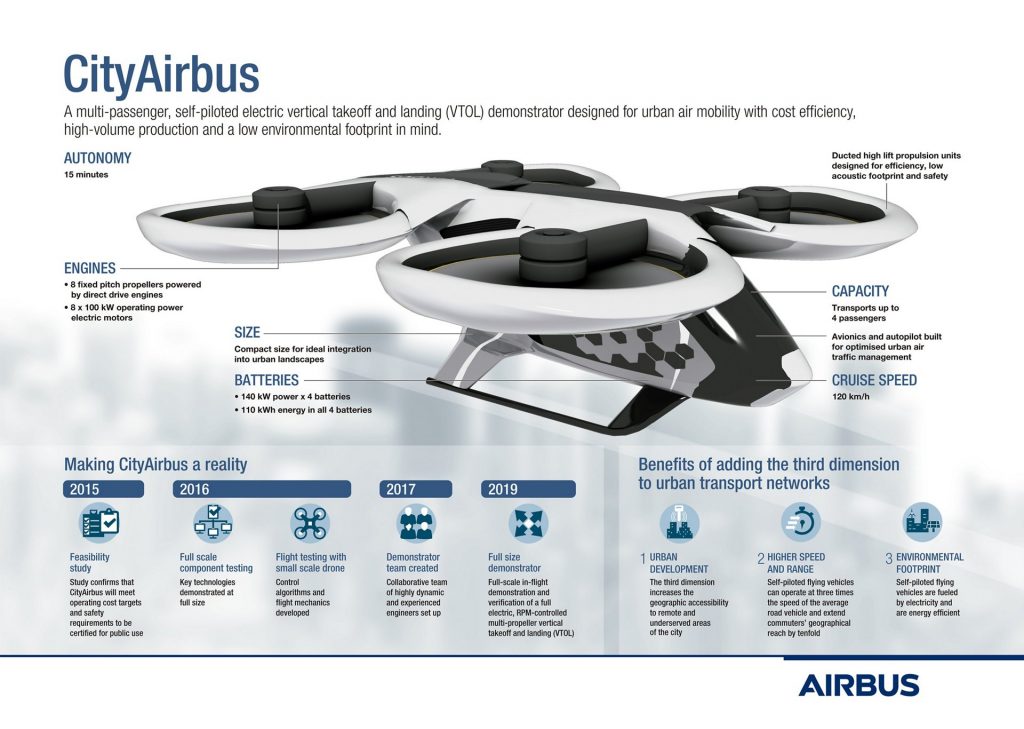
3# ‘MAVERIC’
European aviation company Airbus has unveiled in a radical new potential design for its future aircraft, which breaks the mould of the traditional airplane by blending the wings and body into one wedge-shaped form. The European aircraft maker has released a new curved design that promises to cut fuel consumption up to 20%. The company unveiled its new design at the Singapore Airshow earlier this week, after completing several secret tests on a 3.2-metre-wide, remote-controlled model in France. MAVERIC stands for Model Aircraft for Validation and Experimentation of Robust Innovative Controls, according to Airbus. It’s also a pretty obvious nod to Maverick, Tom Cruise‘s iconic call sign from the fighter-jet film Top Gun.
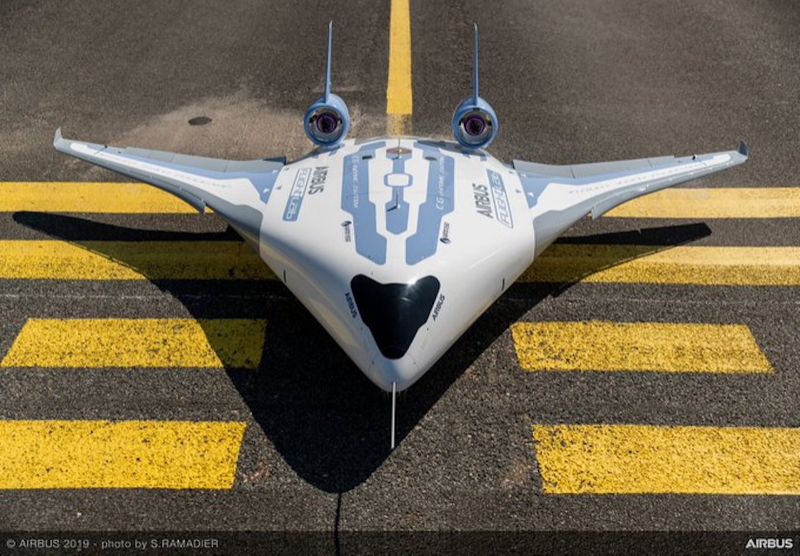
Boeing – Zunum Aero
US multinational Boeing has invested, together with Silicon Valley’s JetBlue Technology Ventures, in Seattle-based startup Zunum Aero. Zunum’s hybrid-electric aircraft promises something akin to door-to-door air travel, flying quietly and economically to thousands of underused local airfields and bypassing more inefficent and often congested larger airports. The initial concept will be able to carry 12 passengers up to 700 miles, but it’s been designed with scalability in mind. The idea is to develop a family of aircraft of increasingly larger size and longer range.
Although it starts as a hybrid, its design allows for a smooth transition to full electrical propulsion when new battery technology becomes available.
Batteries Are Included: Zunum Aero’s regional hybrid-electric plane stores lithium-ion batteries in the wings for supplemental power, particularly on takeoff. Cruising power is generated by a gas turbine linked to a generator, in the back.
A common denominator in these efforts is better batteries, above all lithium-ion batteries, which continue to pack ever more energy into lighter cells. Such energy density is especially critical for aviation. Since 2010, battery pack costs have fallen from US $1,000 per kilowatt-hour to less than $250/kWh today, with a concomitant increase in energy density. Other critical technologies, such as supercapacitors and power converters, have likewise improved by leaps and bounds.
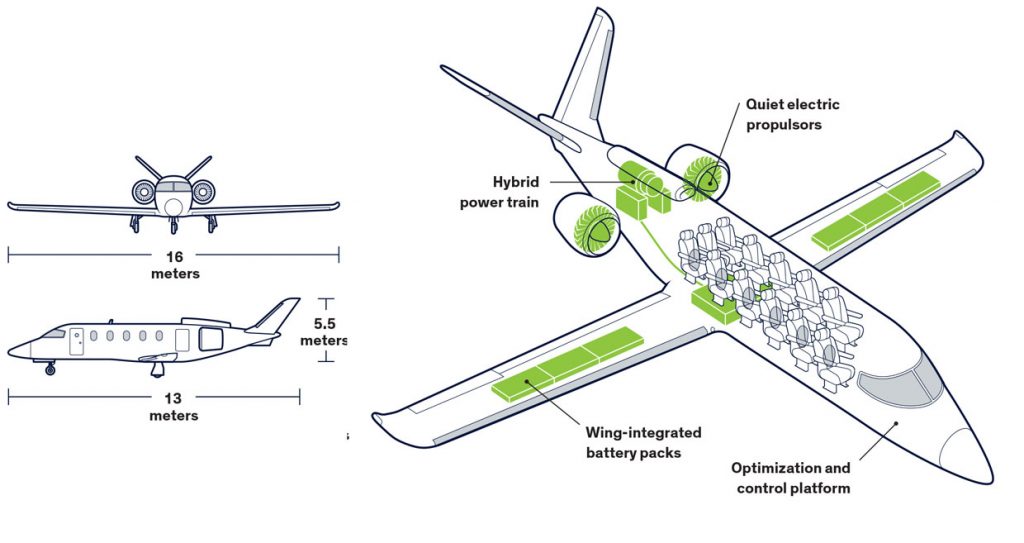
Bell Nexus eVTOL
When it took the wraps off its electric vertical-takeoff-and-landing (eVTOL) air taxi concept in January 2019, Bell revealed a different approach to urban air mobility. A hyrbid-electric propulsion aircraft, the Nexus will use six tilting ducted fans to take off and land vertically from a rooftop or launchpad. And more importantly, you may be able to hail one for a crosstown trip using Uber’s new aerial service in the not-too-distant future. The Nexus can seat five people, and has a gross weight capacity of 600 pounds (272 kilograms). Bell went with a hybrid-electric propulsion system, rather than an all-electric one, so the aircraft could fly further and carry more weight. That’s because Bell doesn’t want the Nexus to be pigeonholed as just an air taxi. In this way, the company can hedge its bets in case this whole flying car craze we’re seeing these days doesn’t actually pan out.
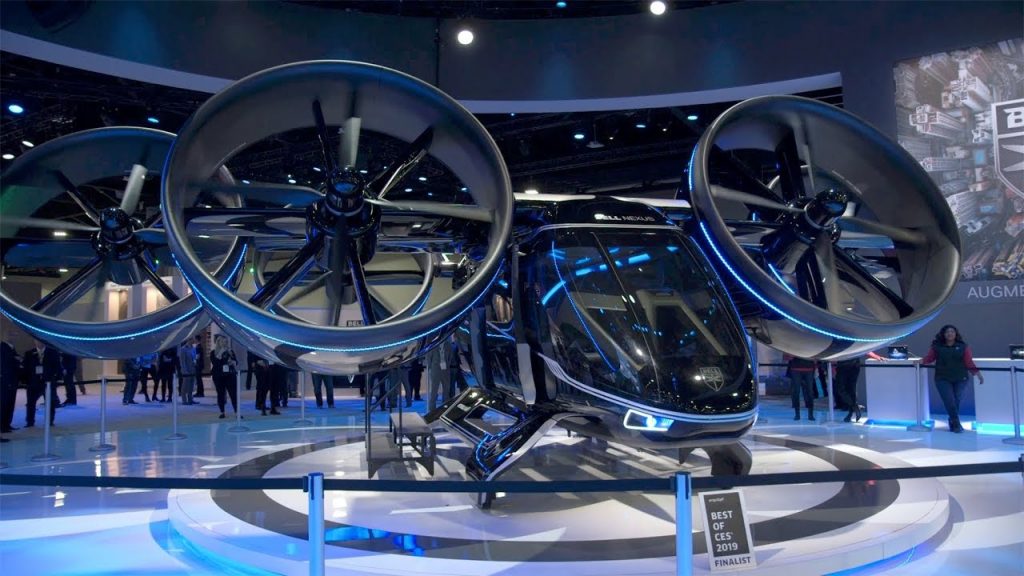
Pipistrel Alpha Electro
Alpha Electro is a 2-seat electric trainer with performance which is tailored to the needs of flight schools. It has short take-off distance, powerful 1000+ fpm climb capability and an endurance of one hour plus a 30-minute reserve. The Alpha Electro is optimized for traffic-pattern operations, where up to 13% of energy is recuperated on every approach, increasing operations range and at the same time enabling short-field landings.
With the ever-growing cost of fuel, it is time to rethink pilot training. Our solution is the first practical all-electric trainer. Technologies which we developed in house specially for this aircraft cut the cost of ab-initio pilot training by as much as 70%, making flying more affordable than ever before.
Every single element of aircraft has been refined to be lighter, more efficient and more reliable than before. The 60+ kW electric motor only weighs 20 kg and is more powerful than the popular Rotax 912 series, typically used on microlights and LSAs. The 21 kWh battery pack is dual-redundant and designed to be either quickly replaceable within minutes or charged in less than one hour, thanks to the next generation of Pipistrel’s Battery Management technology.
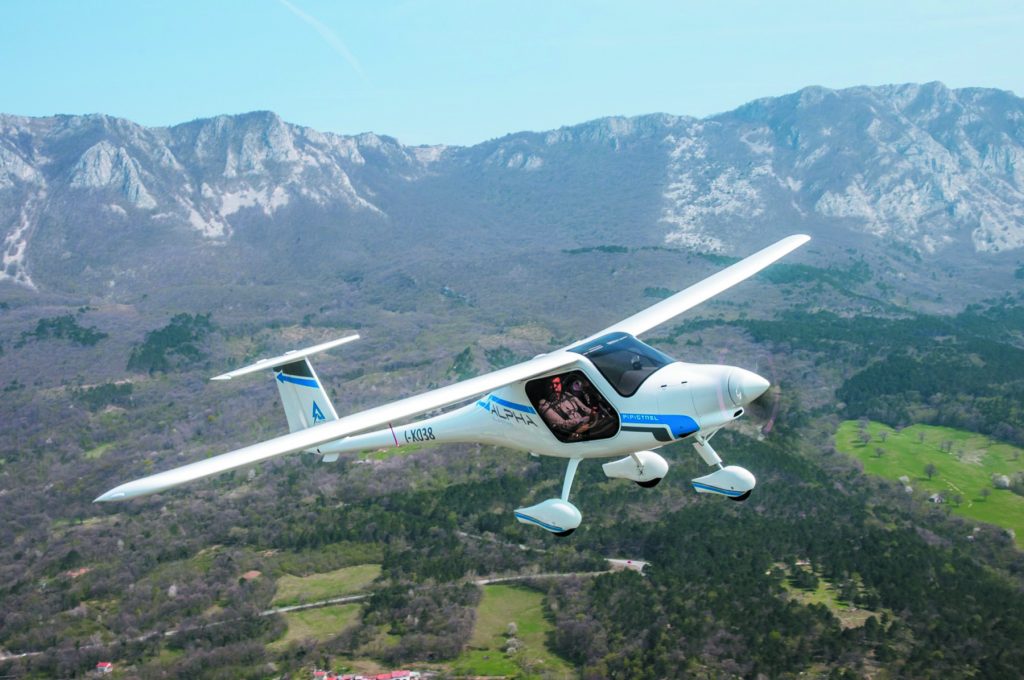
NASA X-57 Maxwell
NASA’s X-57 Maxwell is an example of out-of-the-box thinking when it comes to electrical aircraft design. This awkward-looking experimental plane uses the distributed propulsion provided by 14 electrical motors, all of them integrated into a specially designed high wing.
This unusual configuration, where the two larger motors at the wingtips reduce drag associated with wingtip vortices, is designed to bring about a 500% efficiency increase when cruising at higher speeds.
This solution is yet to be developed and is not used commonly at the moment. Only several test flight were done and most of them were on extremely small aircraft. Of course, using renewables are very appealing but the result at the moment is not satisfactory at all.
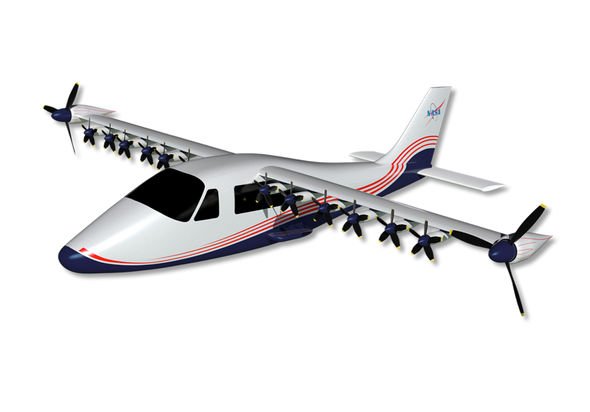
What else can be done?
It is really hard to say, what could be the universal truth for this rising issue. The development of new technologies will eventually serve to the purpose but at this time, it is best to adapt the older fleet to timely standards. The best way to do so is by upgrading the aircraft with spare parts that would help to minimize the consumption of jet fuel even in theoretical level. The reason behind this is that the fleet are not changing fast enough to be up to date with environmental standards and maybe even the smallest adaptations of the aircraft or its engines, while working hand-in-hand with manufacturers and standardization organizations would benefit to the cause.
